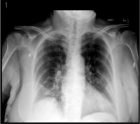Abstract
Research Article
Coronaviruses have reached at Pre-elimination Stage with Nine Amino Acid Spike Deletions and Forty-nine Nucleotide 3’-UTR Deletions
Asit Kumar Chakraborty*
Published: 17 September, 2024 | Volume 8 - Issue 2 | Pages: 031-044
Background: Human 30kb coronaviruses entered through the ACE-2 receptors causing fibrosis of the lungs and causing six million deaths worldwide. Here, we have investigated the mutations, deletions and insertions of the recent JN.1 omicron coronaviruses to demonstrate that coronaviruses have reached the pre-elimination stage.
Methods: We multi-aligned the genomes of recent JN.1 variants using NCBI Virus Portal and CLUSTAL-Omega. The spike proteins are multi-aligned using MultAlin software and CLUSTAL-Omega.
Results: The 17MPLF spike insertion was confirmed to compensate 24LPP, 31S, 69HV, 145Y, 211N and 483V deletions. The 49nt deletions in the 3’-UTR were found in 4997 JN.1 sequences although 26nt deletion was initiated previously in JN.1 as well as BA.5, BF.7, BQ.1 and XBB.1.5 omicron viruses. We first compare 3-D structures of spike proteins with or without 17MPLF four amino acids insertion and nine amino acids deletions using SWISS MODELLING. The JN.1 viruses caused a more stable trimeric spike involving Thr342, Lys436, Lys440, His441, Ser442, Gly443, Tyr445, Lys479, Ser489, Tyr490, Arg493, Pro494, Thr495, and Gln501 amino acids to interact with ACE-2 receptors. The FLiRT spike mutations were found in most KP.2 variants and other changes occurred at the NH2 terminus.
Conclusion: We claimed that pre-death changes were initiated in JN.1 COVID-19 lineages and computer simulation showed that the Howard spike with 17MPLF spike insertion appeared more stable than the Oppentrons-spike without 17MPLF insertion. Surely, conflicts of COVID-19 spike sequences must be resolved.
Read Full Article HTML DOI: 10.29328/journal.ijcv.1001060 Cite this Article Read Full Article PDF
Keywords:
COVID-19 pre-elimination stage; Spike 17MPLF insertion mutants; 31S spike deletion; KP.2 subvariant; 49nt deletion in 3’-UTR; Fraudulent data deposition
References
- Lu R, Zhao X, Li J, Niu P, Yang B, Wang W, et al. Genomic characterisation and epidemiology of 2019 novel coronavirus: Implications for virus origins and receptor binding. Lancet. 2020;395:565-574. Available from: https://www.thelancet.com/journals/lancet/article/PIIS0140-6736(20)30251-8/fulltext
- Peiris M, Poon LLM. Severe Acute Respiratory Syndrome (SARS) and Middle East Respiratory Syndrome (MERS) (Coronaviridae). In: Encyclopedia of Virology. 2021;814–824. Available from: https://doi.org/10.1016%2FB978-0-12-814515-9.00138-7
- Chakraborty AK. Conversion of B.0 lineage of human coronavirus (Covid-19) into notoriously infecting less pathogenic and immune escape omicron B.1.1.529.2.75.2 or BA.2.75.2 variant. J Biomed Res Reports. 2023;2(10). Available from: https://crimsonpublishers.com/cjmi/pdf/CJMI.000648.pdf
- Lu G, Wang Q, Gao GF. Bat-to-human: spike features determining ‘host jump’ of coronaviruses SARS-CoV, MERS-CoV, and beyond. Trends Microbiol. 2015;23:468-478. Available from: https://doi.org/10.1016/j.tim.2015.06.003
- Chakraborty AK, Chanda A. New Biotechnological Exploration on COVID-19 Proteins: Functions, Mutational Profiles and Molecular Targets for Drug Design. Sun Text Rev Virol. 2021;2(1):115. Available from: http://dx.doi.org/10.51737/2766-5003.2021.015
- Das S, Kar SS, Samanta S, J. Banerjee, Giri B, Dash SK, et al. Immunogenic and reactogenic efficacy of Covaxin and Covishield: a comparative review. Immunol Rs. 2022;70(3):289-315. Available from: https://doi.org/10.1007%2Fs12026-022-09265-0
- Jackson CB, Farzan M, Chen B, Choe H. Mechanisms of SARS-CoV-2 entry into cells. Nat Rev Mol Cell Biol. 2022;23(1):3-20. Available from: https://doi.org/10.1038/s41580-021-00418-x
- Huang N, Pérez P, Kato T, Mikami Y, Okuda K. SARS-CoV-2 infection of the oral cavity and saliva. Nat Med. 2021;27(5):892-903. Available from: https://doi.org/10.1038/s41591-021-01296-8
- Chakraborty AK. Hyper-variable Spike Protein of Omicron Corona Virus and its differences with Alpha and Delta Variants: Prospects of RT-PCR and new Vaccine. J Emerg Dis Virol. 2022;7(1):1-13. Available from: https://www.sciforschenonline.org/journals/virology/article-data/JEDV166/JEDV166.pdf
- Korber B, Fischer WM, Gnanakaran S, Yoon H, Theiler J, Montefiori DC, et al. Tracking changes in SARS-CoV-2 spike: Evidence that D614G increases infectivity of the COVID-19 virus. Cell. 2020;182:812-827. Available from: https://doi.org/10.1016/j.cell.2020.06.043
- Liu Y, Liu J, Plante KS, Plante JA, Xie X, Zhang X, et al. The N501Y spike substitution enhances SARS-CoV-2 infection and transmission. Nature. 2022;602(7896):294-299. Available from: https://doi.org/10.1038/s41586-021-04245-0
- Gobeil S, Janowska K, McDowell S, Mansouri K, Parks R, Stalls V, et al. Effect of natural mutations of SARS-CoV-2 on spike structure, conformation, and antigenicity. Science. 2021;373(6555). Available from: https://doi.org/10.1126/science.abi6226
- Chakraborty AK. Coronavirus Nsp2 Protein Homologies to the Bacterial DNA Topoisomerase I and IV Suggest Nsp2 Protein is a Unique RNA Topoisomerase with Novel Target for Drug and Vaccine Development. Virol Mycol. 2020;9:185. Available from: https://www.longdom.org/open-access/coronavirus-nsp2-protein-homologies-to-the-bacterial-dna-topoisomerase-i-and-iv-suggest-nsp2-protein-is-an-unique-rna-topoisomeras-53774.html
- Han P, Li L, Liu S, Fu L, Gao GF, Wang P. Receptor binding and complex structures of human ACE2 to spike RBD from omicron and delta SARS-CoV-2. Cell. 2022;185(4):630-640.e10. Available from: https://doi.org/10.1016/j.cell.2022.01.001
- Sheward DJ, Kim C, Fischbach J, Sato K, Muschiol S, Ehling RA, et al. Omicron sub-lineage BA.2.75.2 exhibits extensive escape from neutralising antibodies. Lancet Infect Dis. 2022;22(11):1538-1540. Available from: https://doi.org/10.1016/s1473-3099(22)00663-6
- Wang Q, Iketani S, Li Z, Liu L, Guo Y, Huang Y, et al. Alarming antibody evasion properties of rising SARS-CoV-2 BQ and XBB subvariants. Cell. 2023;186(2):279-286.e8. Available from: https://doi.org/10.1016/j.cell.2022.12.018
- Zhang J, Xiao T, Cai Y, Chen B. Structure of SARS-CoV-2 spike protein. Curr Opin Virol. 2021;50:173-182. Available from: https://doi.org/10.1016%2Fj.coviro.2021.08.010
- Wang Q, Guo Y, Liu L, Schwanz LT, Li Z, Nair MS, Ho J, et al. Antigenicity and receptor affinity of SARS-CoV-2 BA.2.86 spike. Nature. 2023;624(7992):639-644. Available from: https://doi.org/10.1038/s41586-023-06750-w
- Chakraborty AK. The 249RWMD spike protein insertion in Omicron BQ.1 subvariant compensates the 24LPP and 69HV deletions and may cause more severe disease than BF.7 and XBB.1 subvariants. Int J Clin Med Edu Res. 2023;2(10):254-270. Available from: https://www.opastpublishers.com/open-access-articles/the-249rwmd-spike-protein-insertion-in-omicron-bq1-subvariant-compensates-the-24lpp-and-69hv-deletions-and-may-cause-sev.pdf
- Chakraborty AK. Higher omicron JN.1 and BA.2.86.1 coronavirus transmission due to unique 17MPLF spike insertion compensating 24LPP, 69HV, 145Y, 211N and 483V deletions in the spike. J Future Med Healthcare Innovation. 2024;21(1):1-20. Available from: https://www.opastpublishers.com/open-access-articles/higher-omicron-jn1-and-ba2861-coronavirus-transmission-due-to-unique17-mplf-spike-insertion-compensating-24lpp-69hv-145y.pdf
- Gao Y, Yan L, Huang Y, Liu F, Zhao Y, Cao L, et al. Structure of the RNA-dependent RNA polymerase from COVID-19 virus. Science. 2020;368:779-782. Available from: https://doi.org/10.1126/science.abb7498
- Chakraborty AK. Dynamics of SARS-CoV-2 ORF7a Gene Deletions and Fate of Downstream ORF7b and ORF8 Genes Expression. SunText Rev Biotechnol. 2022;3(1):142. Available from: https://doi.org/10.51737/2766-5097.2022.042
- Chakraborty AK. Highly Infectious, Less Pathogenic and Antibody Resistant Omicron Xbb.1, Xbb.1.5 and Xbb.1.5.1- Xbb.1.5.39 Subvariant Coronaviruses Do Not Produce Orf8 Protein Due To 8th Codon Gga=Tga Termination Codon Mutation. Cohesive J Microbiol Infect Dis. 2023;6(5).000648. Available from: https://crimsonpublishers.com/cjmi/pdf/CJMI.000648.pdf
- Chakraborty AK. SARS-CoV-2 ORF8 gene CAA=TAA and AAA=TAA termination codon mutations found mostly in B.1.1.7 variant was independent of popular L84S mutations. Int J Clin Med Edu Res. 2022;1(6):192-208. Available from: https://www.opastpublishers.com/open-access-articles/sarscov2-orf8-gene-caataa-and-aaataa-termination-codon-mutations-found-mostly-in-b117-variants-was-independent-of-popula.pdf
- Chakraborty AK. Rapid worldwide spread of 17MPLF spike insertion mutants (JN.1-JN.1.25, KP.1, KP.2, KQ.1, KR.1, XDD, XDP, XDK, XDQ subvariants) of omicron coronaviruses and spike gene 5’-end sequencing problem. Res Square. 2024. Available from: https://doi.org/10.21203/rs.3.rs-4741070/v1
- Yang Y, Jiang XT, Zhang T. Evaluation of a Hybrid Approach using UBLAST and BLASTX for Metagenomic Sequences Annotation of specific functional genes. PLoS One. 2014;9(10). Available from: https://doi.org/10.1371%2Fjournal.pone.0110947
- Altschul SF, Gish W, Miller W, Myers EW, Lipman DJ. Basic local alignment search tool. J Mol Biol. 1990;215:403–410. Available from: https://doi.org/10.1016/s0022-2836(05)80360-2
- Corpet F. Multiple sequence alignment with hierarchical clustering. Nucleic Acids Res. 1988;16:10881-10890. Available from: https://doi.org/10.1093%2Fnar%2F16.22.10881
- Wallace IM, Blackshields G, Higgins DG. Multiple sequence alignments. Curr Opin Struct Biol. 2005;15(3):261–266. Available from: https://doi.org/10.1016/j.sbi.2005.04.002
- Sievers F, Wilm A, Dineen DG, Gibson TJ, Karplus K, Li W, et al. Fast, scalable generation of high-quality protein multiple sequence alignments using Clustal Omega. Mol Syst Biol. 2011;7:539. Available from: https://doi.org/10.1038/msb.2011.75
- Waterhouse A, Bertoni M, Bienert S, Studer G, Tauriello G, Gumienny R, et al. SWISS-MODEL: homology modelling of protein structures and complexes. Nucleic Acids Res. 2018;46. Available from: https://doi.org/10.1093%2Fnar%2Fgky427
- Studer G, Tauriello G, Bienert S, Biasini M, Johner N, Schwede T. A versatile homology modelling toolbox. PLoS Comput Biol. 2021;17(1). Available from: https://doi.org/10.1371/journal.pcbi.1008667
- Varadi M, Anyango S, Deshpande M, Nair S, Natassia C, Yordanova G, et al. AlphaFold protein structure database: massively expanding the structural coverage of protein-sequence space with high accuracy models. Nucleic Acids Res. 2022;50. Available from: https://doi.org/10.1093/nar/gkab1061
- Zhao J, Qiu J, Aryal S, Hackett JL, Wang J. The RNA Architecture of the SARS-CoV-2 3'-Untranslated Region. Viruses. 2020;12(12):1473. Available from: https://doi.org/10.3390/v12121473
- Hendrickson EN, Ericson ME, Bemis LT. Host tRNA-Derived RNAs Target the 3'-Untranslated Region of SARS-CoV-2. Pathogens. 2022;11(12):1479. Available from: https://doi.org/10.3390/pathogens11121479
- Hernández-Huerta MT, Pérez-Campos Mayoral L, Matias-Cervantes CA, Romero Díaz C, Cruz Parada E, Pérez-Campos Mayoral E, et al. 3'-UTR of the SARS-CoV-2 genome as a possible source of piRNAs. Genes Dis. 2023;10(3):668-670. Available from: https://doi.org/10.1016/j.gendis.2022.05.028
- Pérez-Campos Mayoral L, Hernández-Huerta MT, Romero Díaz C, Matias-Cervantes CA, Pérez-Campos Mayoral E, Martínez Cruz M, et al. Interaction of piRNA-like sequences from the 3'-UTR of SARS-CoV-2 with mRNA regions. Genes Dis. 2023;10(6):2282-4. Available from: https://doi.org/10.1016%2Fj.gendis.2023.01.012
- Mukherjee M, Goswami S. Global cataloguing of variations in untranslated regions of viral genome and prediction of key host RNA binding protein-microRNA interactions modulating genome stability in SARS-CoV-2. PLoS One. 2020;15(8). Available from: https://doi.org/10.1371%2Fjournal.pone.0237559
- Meseguer S, Rubio MP, Lainez B, Pérez-Benavente B, Pérez-Moraga R, Romera-Giner S, et al. SARS-CoV-2-encoded small RNAs are able to repress the host expression of SERINC5 to facilitate viral replication. Front Microbiol. 2023;14:1066493. Available from: https://doi.org/10.3389/fmicb.2023.1066493
- Hagey RJ, Elazar M, Pham EA, Tian S, Ben-Avi L, Bernardin-Souibgui C, et al. Programmable antivirals targeting critical conserved viral RNA secondary structures from influenza A virus and SARS-CoV-2. Nat Med. 2022;28(9):1944-1955. Available from: https://doi.org/10.1038/s41591-022-01908-x
- Chakraborty AK. Multi-Alignment Comparison of Coronavirus Non-Structural Proteins Nsp13-16 with Ribosomal Proteins and Other DNA/RNA Modifying Enzymes Suggested Their Roles in the Regulation of Host Protein Synthesis. Int J Clin Med Informatics. 2020;3:7-19. Available from: https://osf.io/preprints/indiarxiv/qrxc5
- Zhang J, Cai Y, Lavine CL, Lu J, Xiao T, Chen B. Structural and functional impact by SARS-CoV-2 Omicron spike mutations. Cell Rep. 2022;39(4):110729. Available from: https://doi.org/10.1016/j.celrep.2022.110729
- McCallum M, Walls AC, Bowen JE, et al. Structure-guided covalent stabilization of coronavirus spike glycoprotein trimers in the closed conformation. Nat Struct Mol Biol. 2020;27:942-949. Available from: https://doi.org/10.1038/s41594-020-0483-8
- Ou X, Guan H, Qin B, Corti D, Veesler D. Crystal structure of the receptor binding domain of the spike glycoprotein of human betacoronavirus HKU1. Nat Commun. 2017;8:15216. Available from: https://www.nature.com/articles/ncomms15216
- Walls AC, Tortorici MA, Bosch BJ, Frenz B, Rottier PJM, DiMaio F, et al. Cryo-electron microscopy structure of a coronavirus spike glycoprotein trimer. Nature. 2016;531(7592):114-117. Available from: https://doi.org/10.1038/nature16988
- Dey S, Chakraborty P, Janin J. A survey of haemoglobin quaternary structures. Proteins. 2011;79(10):2861-2870. doi: 10.1002/prot.23112. Available from: https://doi.org/10.1002/prot.23112
- Lemmin T, Kalbermatter D, Harder D, Plattet P, Fotiadis D. Structures and dynamics of the novel S1/S2 protease cleavage site loop of the SARS-CoV-2 spike glycoprotein. J Struct Biol. 2020;4:100038. doi: 10.1016/j.yjsbx.2020.100038. Available from: https://doi.org/10.1016/j.yjsbx.2020.100038
- Haseeb M, Amir A, Ikram A. In Silico Analysis of SARS-CoV-2 Spike Proteins of Different Field Variants. Vaccines (Basel). 2023 Mar 27;11(4):736. Available from: https://doi.org/10.3390%2Fvaccines11040736
- Ortega JT, Jastrzebska B, Rangel HR. Omicron SARS-CoV-2 Variant Spike Protein shows an increased affinity to the Human ACE2 Receptor: An in-silico analysis. Pathogens. 2021;11(1):45. Available from: https://doi.org/10.3390/pathogens11010045
- Choi HS, Choi AY, Kopp JB, Winkler CA, Cho SK. Review of COVID-19 therapeutics by mechanism: from discovery to approval. J Korean Med Sci. 2024;39(14). Available from: https://doi.org/10.3346/jkms.2024.39.e134
- Wang H, Xue Q, Zhang H, Yuan G, Wang X, Sheng K, et al. Neutralization against omicron subvariants after BA.5/BF.7 breakthrough infection weakened as virus evolution and ageing despite prototype-based vaccination. Emerg Microbes Infect. 2023;12(2):2249121. Available from: https://doi.org/10.1080/22221751.2023.2249121
- Yang S, et al. Fast evolution of SARS-CoV-2 BA.2.86 to JN.1 under heavy immune pressure. Lancet Infect Dis. 2023;15(23).
Figures:
Similar Articles
Recently Viewed
-
Do Fishes Hallucinate Human Folks?Dinesh R*,Sherry Abraham,Kathiresan K,Susitharan V,Jeyapavithran C,Paul Nathaniel T,Siva Ganesh P. Do Fishes Hallucinate Human Folks?. Arch Food Nutr Sci. 2017: doi: 10.29328/journal.afns.1001003; 1: 020-023
-
Assessment of Redox Patterns at the Transcriptional and Systemic Levels in Newly Diagnosed Acute LeukemiaAna Carolina Agüero Aguilera, María Eugenia Mónaco, Sandra Lazarte, Emilse Ledesma Achem, Natalia Sofía Álvarez Asensio, Magdalena María Terán, Blanca Alicia Issé, Marcela Medina, Cecilia Haro*. Assessment of Redox Patterns at the Transcriptional and Systemic Levels in Newly Diagnosed Acute Leukemia. J Hematol Clin Res. 2024: doi: 10.29328/journal.jhcr.1001029; 8: 017-023
-
Assessment of Indigenous Knowledge on Using of Traditional Medicinal Plants to Cure Human Diseases in South Omo Zone Baka Dawla Ari District, Kure and Bitsmal South EthiopiaGizaw Bejigo*. Assessment of Indigenous Knowledge on Using of Traditional Medicinal Plants to Cure Human Diseases in South Omo Zone Baka Dawla Ari District, Kure and Bitsmal South Ethiopia. J Plant Sci Phytopathol. 2024: doi: 10.29328/journal.jpsp.1001132; 8: 048-054
-
Nanoencapsulated Extracts from Leaves of Bauhinia forficata Link: In vitro Antioxidant, Toxicogenetic, and Hypoglycemic Activity Effects in Streptozotocin-induced Diabetic MiceBárbara Verônica Cardoso de Souza, Alessandra Braga Ribeiro*, Rita de Cássia Meneses Oliveira, Julianne Viana Freire Portela, Ana Amélia de Carvalho Melo Cavalcante, Esmeralda Maria Lustosa Barros, Luís Felipe Lima Matos, Tarsia Giabardo Alves, Maria. Nanoencapsulated Extracts from Leaves of Bauhinia forficata Link: In vitro Antioxidant, Toxicogenetic, and Hypoglycemic Activity Effects in Streptozotocin-induced Diabetic Mice. Arch Pharm Pharma Sci. 2024: doi: 10.29328/journal.apps.1001063; 8: 100-115
-
GELS as Pharmaceutical Form in Hospital Galenic Practice: Chemico-physical and Pharmaceutical AspectsLuisetto M*,Edbey Kaled,Mashori GR,Ferraiuolo A,Fiazza C,Cabianca L,Latyschev OY. GELS as Pharmaceutical Form in Hospital Galenic Practice: Chemico-physical and Pharmaceutical Aspects. Arch Surg Clin Res. 2025: doi: 10.29328/journal.ascr.1001084; 9: 001-007
Most Viewed
-
Evaluation of Biostimulants Based on Recovered Protein Hydrolysates from Animal By-products as Plant Growth EnhancersH Pérez-Aguilar*, M Lacruz-Asaro, F Arán-Ais. Evaluation of Biostimulants Based on Recovered Protein Hydrolysates from Animal By-products as Plant Growth Enhancers. J Plant Sci Phytopathol. 2023 doi: 10.29328/journal.jpsp.1001104; 7: 042-047
-
Sinonasal Myxoma Extending into the Orbit in a 4-Year Old: A Case PresentationJulian A Purrinos*, Ramzi Younis. Sinonasal Myxoma Extending into the Orbit in a 4-Year Old: A Case Presentation. Arch Case Rep. 2024 doi: 10.29328/journal.acr.1001099; 8: 075-077
-
Feasibility study of magnetic sensing for detecting single-neuron action potentialsDenis Tonini,Kai Wu,Renata Saha,Jian-Ping Wang*. Feasibility study of magnetic sensing for detecting single-neuron action potentials. Ann Biomed Sci Eng. 2022 doi: 10.29328/journal.abse.1001018; 6: 019-029
-
Pediatric Dysgerminoma: Unveiling a Rare Ovarian TumorFaten Limaiem*, Khalil Saffar, Ahmed Halouani. Pediatric Dysgerminoma: Unveiling a Rare Ovarian Tumor. Arch Case Rep. 2024 doi: 10.29328/journal.acr.1001087; 8: 010-013
-
Physical activity can change the physiological and psychological circumstances during COVID-19 pandemic: A narrative reviewKhashayar Maroufi*. Physical activity can change the physiological and psychological circumstances during COVID-19 pandemic: A narrative review. J Sports Med Ther. 2021 doi: 10.29328/journal.jsmt.1001051; 6: 001-007

HSPI: We're glad you're here. Please click "create a new Query" if you are a new visitor to our website and need further information from us.
If you are already a member of our network and need to keep track of any developments regarding a question you have already submitted, click "take me to my Query."

















































































































































